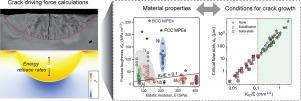Assessment of critical flaw sizes and crack driving forces during additive manufacturing of metallic materials
IF 11.1
1区 工程技术
Q1 ENGINEERING, MANUFACTURING
引用次数: 0
Abstract
Additive manufacturing (AM) of complex engineering components is often plagued by a high susceptibility to cracking, particularly in high-strength metallic materials. While alloy design efforts have made progress in mitigating solidification defects, there remains a need for mechanistic guidelines to predict susceptibility to solid-state cracking. To address this gap, driving forces for the growth of melt pool cracks are calculated across a wide range of alloys using an efficient computational framework. Calculations are coupled with rapid single track laser experiments to elucidate trends in cracking from laser melting. The analyses conducted here highlight the important role of material properties in susceptibility to cracking, notably fracture toughness and elastic modulus. An important finding is that residual stresses that are limited in magnitude to the yield stress of the material are likely insufficient to drive cracking during cooling. The implications of these results are discussed in the context of alloy design for AM and residual stress accumulation during AM.

金属材料增材制造过程中临界缺陷尺寸和裂纹驱动力的评估
复杂工程部件的增材制造(AM)经常受到高开裂敏感性的困扰,特别是在高强度金属材料中。虽然合金设计在减轻凝固缺陷方面取得了进展,但仍然需要力学指导来预测对固态开裂的敏感性。为了解决这一差距,使用高效的计算框架在广泛的合金中计算熔池裂纹增长的驱动力。计算与快速单轨激光实验相结合,阐明了激光熔化开裂的趋势。这里进行的分析强调了材料性能在开裂敏感性中的重要作用,特别是断裂韧性和弹性模量。一个重要的发现是,在材料屈服应力范围内的残余应力可能不足以在冷却过程中驱动开裂。这些结果的意义讨论了合金设计的背景下增材制造和残余应力积累过程中的增材制造。
本文章由计算机程序翻译,如有差异,请以英文原文为准。
求助全文
约1分钟内获得全文
求助全文
来源期刊

Additive manufacturing
Materials Science-General Materials Science
CiteScore
19.80
自引率
12.70%
发文量
648
审稿时长
35 days
期刊介绍:
Additive Manufacturing stands as a peer-reviewed journal dedicated to delivering high-quality research papers and reviews in the field of additive manufacturing, serving both academia and industry leaders. The journal's objective is to recognize the innovative essence of additive manufacturing and its diverse applications, providing a comprehensive overview of current developments and future prospects.
The transformative potential of additive manufacturing technologies in product design and manufacturing is poised to disrupt traditional approaches. In response to this paradigm shift, a distinctive and comprehensive publication outlet was essential. Additive Manufacturing fulfills this need, offering a platform for engineers, materials scientists, and practitioners across academia and various industries to document and share innovations in these evolving technologies.
 求助内容:
求助内容: 应助结果提醒方式:
应助结果提醒方式:


